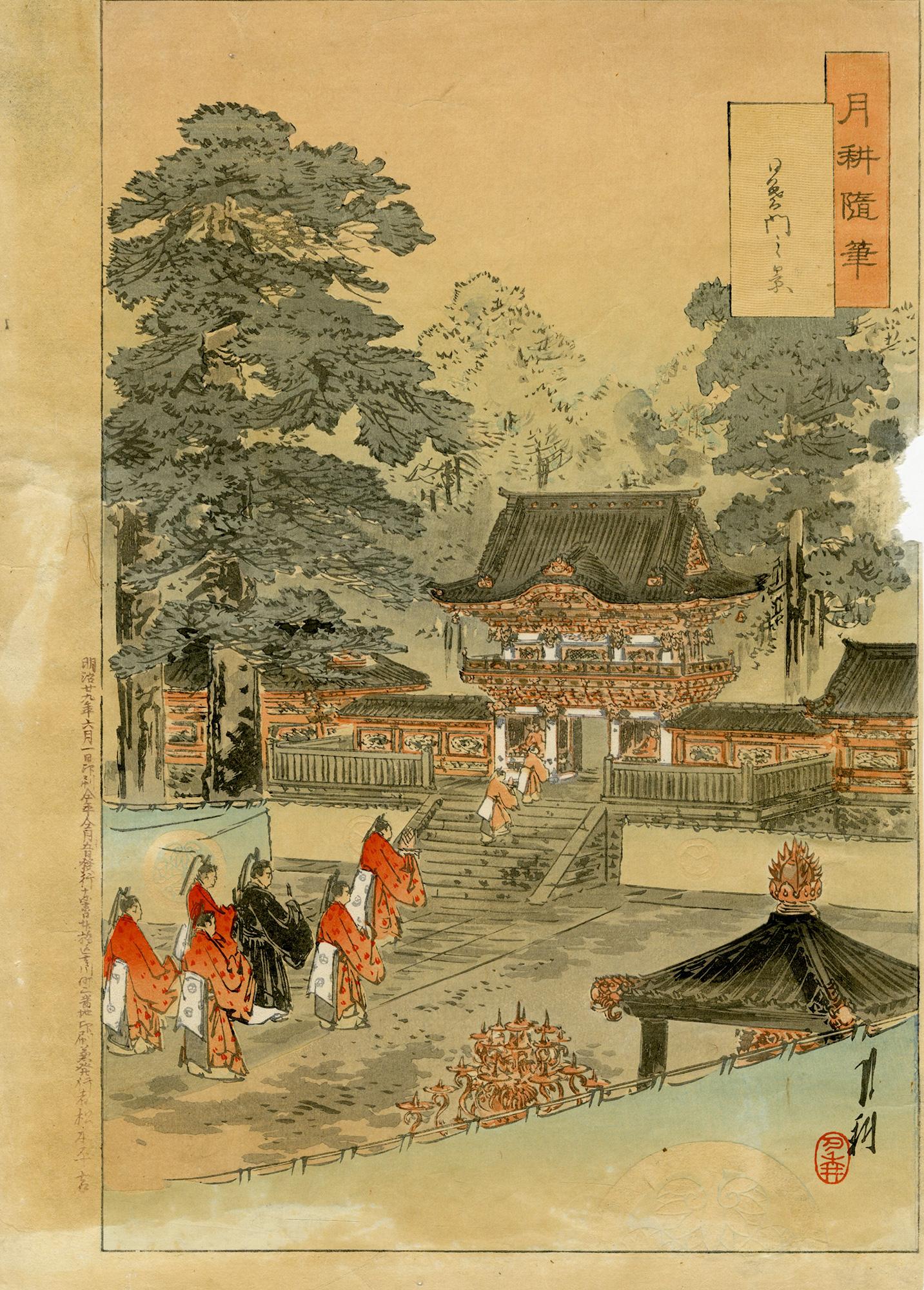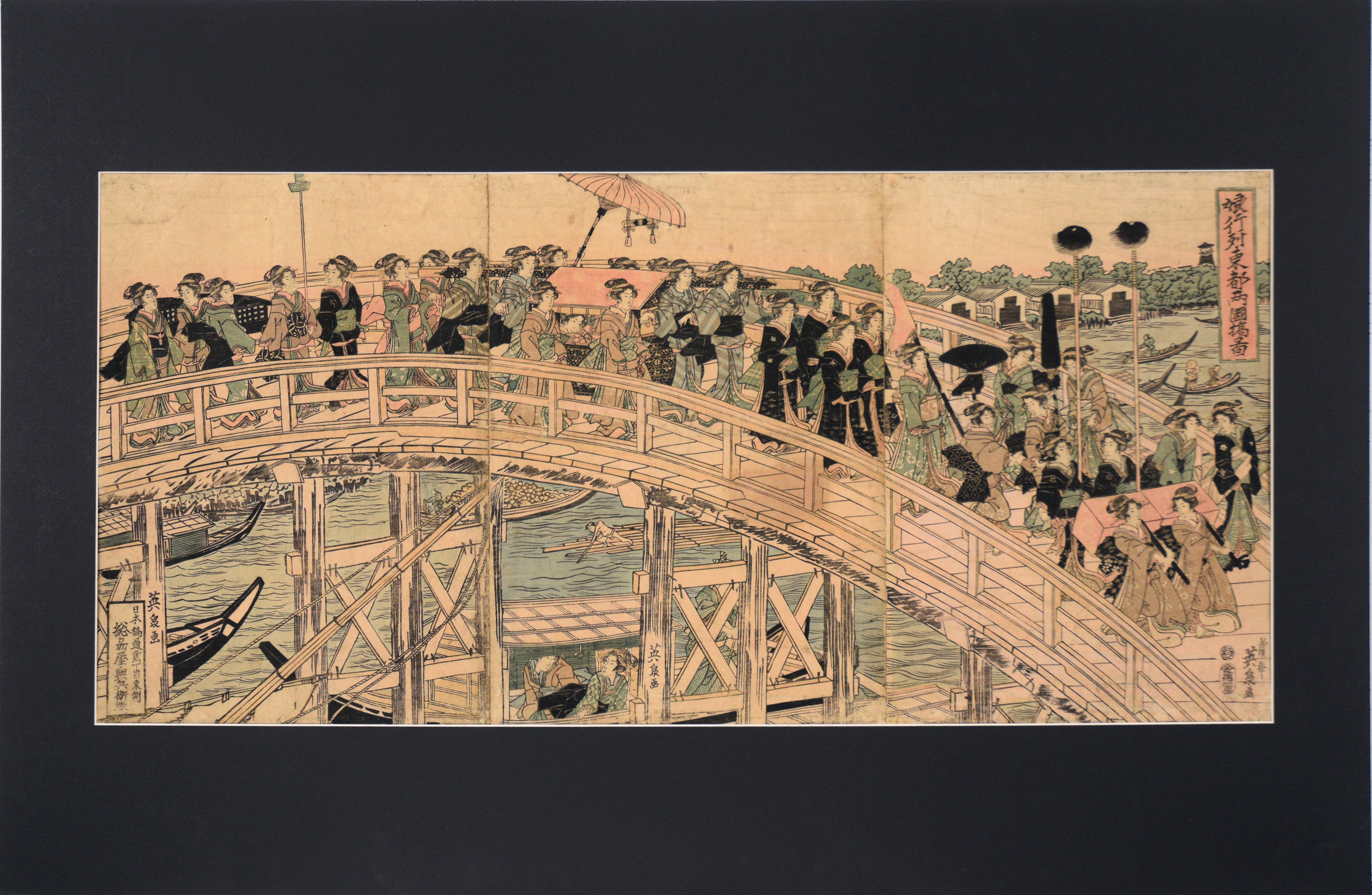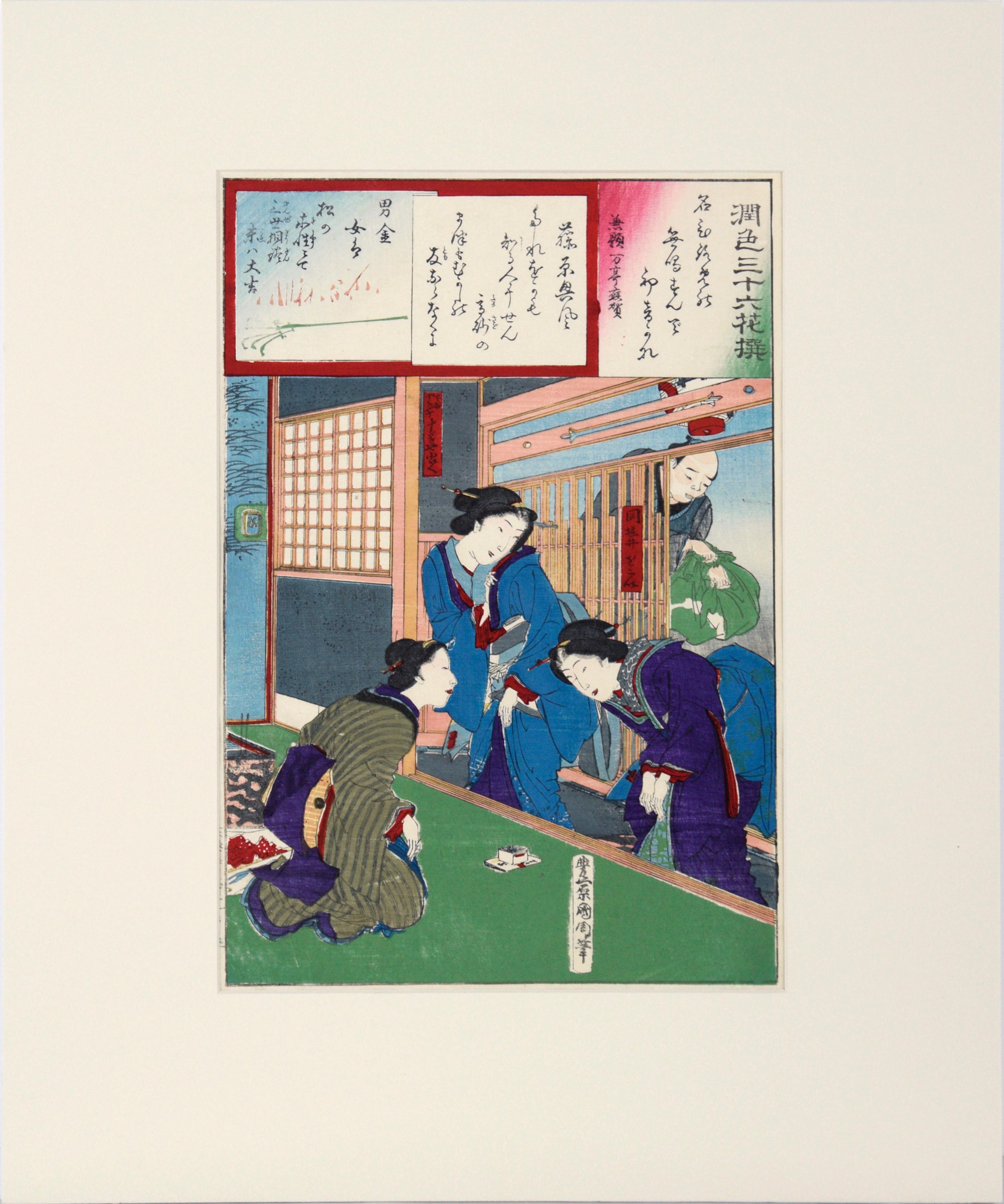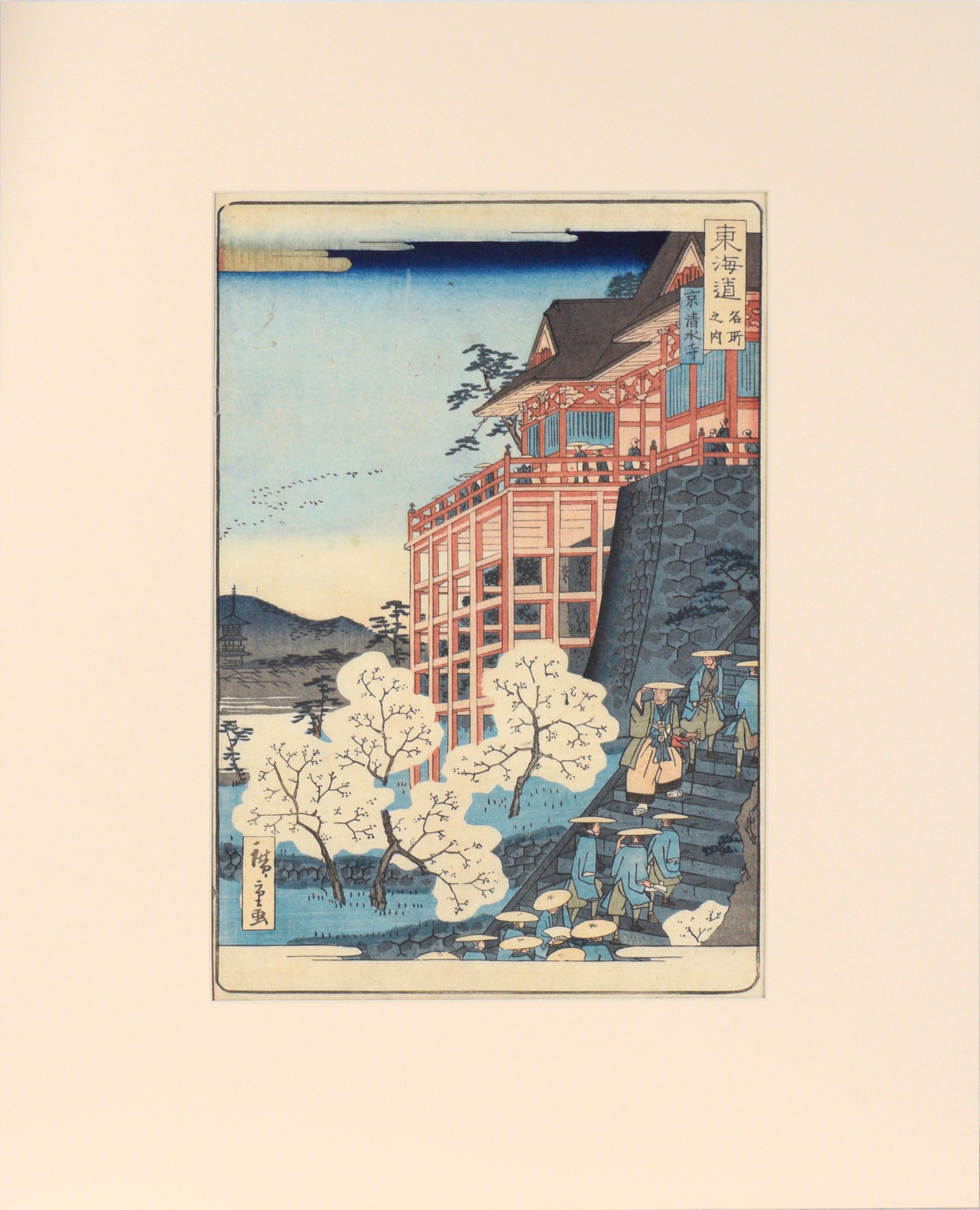Items Similar to The Battle of Dan-no-ura in Yashima, Nagato Province in the First Year .....
Want more images or videos?
Request additional images or videos from the seller
1 of 3
Utagawa YoshitoraThe Battle of Dan-no-ura in Yashima, Nagato Province in the First Year .....1830
1830
About the Item
The Battle of Dan-no-ura in Yashima, Nagato Province in the First Year of the Bunji Era (1185)
Tokyo c. 1830
Woodblock print (nishiki-e) with ink and hand-coloring in watercolor on handmade mulberry paper, 14 7/16 x 9 15/16 inches (367 x 252 mm), ōban tate-e, the full sheet. In good condition with some handling creases. Colors are fresh and extremely vibrant. The right panel from the triptych by Yoshitora depicting one of Japan's most storied naval battles. An impression of this work may be found in the permanent collection of the Honolulu Museum of Art.
The great naval battle of Dan-no-ura in 1185 was the final climax in a long series of bitter wars between two powerful families in feudal Japan. The Minamato clan, under their skilled military leader Yoshitsune, defeated the Taira. The protracted naval battle at the narrow straits separating the mainland from the northern tip of Kyushu marked a decisive end to the Gempei War, and set the stage for centuries of samurai rule. This defeat of the Taira forces led to the end of the Taira bid for control of Japan, and resulted in Minamoto no Yoritomo becoming the first shōgun of Japan.
- Creator:Utagawa Yoshitora (Japanese)
- Creation Year:1830
- Dimensions:Height: 14.44 in (36.68 cm)Width: 9.94 in (25.25 cm)
- Medium:
- Movement & Style:
- Period:
- Condition:
- Gallery Location:Middletown, NY
- Reference Number:
About the Seller
5.0
Vetted Seller
These experienced sellers undergo a comprehensive evaluation by our team of in-house experts.
Established in 2004
1stDibs seller since 2022
29 sales on 1stDibs
Typical response time: 12 hours
- ShippingRetrieving quote...Ships From: Middletown, NY
- Return PolicyA return for this item may be initiated within 30 days of delivery.
More From This SellerView All
- Toshogu ShrineLocated in Middletown, NYIn image of the Tokugawa family paying homage to Tosho-gu Shrine in Nikko. Tokyo: Matsuki Heikichi, 1896 Woodcut in ink with embossing and hand-coloring in watercolor on handmade m...Category
Late 19th Century Edo Figurative Prints
MaterialsHandmade Paper, Watercolor, Woodcut
- Ceiling plan of Crosby Hall, Bishopsgate StreetLocated in Middletown, NYRobert Wilkinson, 1816. Copperplate engraving on buff wove paper with hand coloring in watercolor, 10 7/8 x 13 /4 inches (275 x 336 mm), full margins. In good condition with some sc...Category
Early 19th Century English School Landscape Prints
MaterialsEngraving, Watercolor, Handmade Paper
- North Side of the Great Court, Sommerset PalaceLocated in Middletown, NYAquatint printed in brownish ink with extensive hand coloring in watercolor on buff paper, 10 1/4 x 12 1/2 inches (260 x 317 mm) (sheet), uneven narrow to full margins. Laid down to ...Category
Late 18th Century English School Landscape Prints
MaterialsAquatint, Handmade Paper, Watercolor
- St. Paul's From Ludgate Hill, from Original Views of London As It IsBy Thomas Shotter BoysLocated in Middletown, NYLithograph with hand tinting on heavy wove paper, full margins. Significant condition issues in the margins which include adhesive residue, edge tears and minor edge losses. The image area is clean with minor mat tone, however, colors are slightly attenuated. The verso shows moderate uneven toning. Issues primarily exist outside of the image area. This large and lively work was printed by Charles Hullmandel. _______ The images in Boys's 1842 portfolio, Original Views of London...Category
Mid-19th Century English School Landscape Prints
MaterialsWatercolor, Handmade Paper, Lithograph
- Chateau de VerneuilBy Matthäus Merian the ElderLocated in Middletown, NYEngraving with hand coloring and heightening in watercolor on two leaves of expertly conjoined handmade laid paper, one leaf with a large watermark a feathered dragon, 7 1/4 x 11 1/4...Category
Mid-17th Century Old Masters Landscape Prints
MaterialsWatercolor, Handmade Paper, Engraving
- Arc de Triomphe de L'ÉtoileBy Philippe BenoistLocated in Middletown, NYfrom "Paris dans sa Splendeur: Monuments, Vues, Scènes Historiques, Descriptions et Histoire." Lithograph and engraving with hand coloring in watercolor on cream wove paper, 9 3/8 x ...Category
Mid-19th Century Barbizon School Landscape Prints
MaterialsWatercolor, Handmade Paper, Engraving, Lithograph
You May Also Like
- Mitate of a Daimyo's Procession Crossing Ryogoku Bridge - Woodblock PrintBy Keisai EisenLocated in Soquel, CAMitate of a Daimyo's Procession Crossing Ryogoku Bridge - Woodblock Print Woodblock print of a procession by Keisai Eisen (Japanese, 1790–1848). Terrific triptych of a procession of...Category
Early 19th Century Edo Figurative Prints
MaterialsWoodcut, Rice Paper, Ink
- "Enshoku Sanju-roku Kasen" (Thirty-six Enchanting Flowers) Woodblock on paperBy Toyohara KunichikaLocated in Soquel, CA"Enshoku Sanju-roku Kasen" (Thirty-six Enchanting Flowers) Woodblock on paper Elegant woodblock print by Toyohara Kunuchika (Japanese, 1835-1900). Three women are in talking with each other inside, while a man waits outside holding a bag of some kind. The colors in this piece are rich and saturated, primarily blues, greens, and purple. Mat size: 16"H x 20"W Paper size: 14.75"H x 9.88"W Born in 1835, Toyohara Kunichika grew up in the Kyobashi district of Edo in the midst of merchants and artisans. In 1848, at age 13, he was accepted as an apprentice into the studio of Utagawa Kunisada I...Category
1880s Edo Figurative Prints
MaterialsInk, Rice Paper, Woodcut
- Beauties on the Beach with view of Mount FujiBy Yoshu ChikanobuLocated in Burbank, CAShichirigahama, Sagami Province. A beauty in the foreground waves to her young companions, who run towards her on the beach. The beauty at left wears a western-style golden ring. We ...Category
1890s Edo Landscape Prints
MaterialsHandmade Paper, Mulberry Paper, Woodcut
- Kiyomizu Temple, Scenes of Famous Places along Tôkaidô Road - Woodblock on PaperBy Utagawa Hiroshige IILocated in Soquel, CAKiyomizu Temple, Scenes of Famous Places along Tôkaidô Road - Woodblock on Paper Full Title: Kyoto: Kiyomizu Temple (Kyô Kiyomizudera), from the series Scenes of Famous Places along...Category
1860s Edo Landscape Prints
MaterialsInk, Rice Paper, Woodcut
- Narihira's Journey to the East - Japanese Woodblock on Paper by Kikugawa EizanBy Kikugawa EizanLocated in Soquel, CANarihira's Journey to the East - Japanese Woodblock on Paper Original 19th century Japanese woodcut print depicting Narihira's journey to the East by a follower of Utamaru, Kikugaw...Category
Early 19th Century Edo Figurative Prints
MaterialsWoodcut, Rice Paper, Ink
- "Various Himochi" Wagashi Festival Japanese Woodblock Print by Utagawa ToyokuniLocated in Soquel, CA"Various Himochi" Wagashi Festival Japanese Woodblock Print by Utagawa Toyokuni Rare oversized early 19th century 5-tiered woodblock by Utagawa Ichiyosai Toyokuni, (Japan, 1769-1825), a Japanese lord and wife oversee a sekku festival of food, music, and dolls or toys. '"oshi" is the first day of “Mi (Snake)” in the third month of the lunar calendar. This day, known in modern Japan as the Girls' Festival, originated in China as a form of purification ceremony in which water and drinking peach blossom wine were used to drive away evil. Many kinds of hishi-mochi appear in this picture of hina ningyo (dolls associated with Hinamatsuri, or the Girl’s Day) from Omochae. The custom of eating special dishes at events throughout the year and at milestones in people's lives has existed since ancient times. This paragraph specifically focuses on the annual event called sekku, and life events that involve eating sweets. Joshi is the first day of “Mi (Snake)” in the third month of the lunar calendar. This day, known in modern Japan as the Girls' Festival, originated in China as a form of purification ceremony in which water and drinking peach blossom wine were used to drive away evil. According to the Keiso saijiki, in ancient China, on the third day of the third lunar month, people ate “ryuzetsuhan,” which is the juice of gogyo (Jersey cudweed) mixed with rice flour and nectar. In Japan, there is a record in the Heian period history book Nihon Montoku tenno jitsuroku [839-5] that it was an annual event to make kusamochi using gogyo on the third day of the third month of the lunar calendar, which may have been influenced by Chinese customs. The tradition of eating kusamochi on the third day of the third month of the lunar calendar continued after that. By the Edo period, however, hishimochi had come to be used as a sweet to serve on the third day of the third month. A picture of a hishimochi is included in the Morisada manko , which we mentioned in Part 1. According to it, hishimochi in the Edo period were often three layers of green-white-green instead of the now common red-white-green. However, it is possible to see from our collection that not all hishimochi were made in this way. Omochae published in 1857, is a good example. Omochae is a type of ukiyoe print...Category
1820s Edo Figurative Prints
MaterialsInk, Rice Paper, Woodcut
Recently Viewed
View AllMore Ways To Browse
Female English Painter 21 Century Characters
Leech Vintage
Matisse Bal
Orient Deluxe
Peter Max Swami
Pursuit Man O War
Vintage Yves Saint Laurent Poster
Wassily Cow
Wood Green Lunch Box
1945 Swiss Made Music Box
Andy Warhol Soup Dress
Antique Curtain Pole
Antique Japanese Cut Paper Out Art
Brutal Bed
Chagall Rooster
Friday The 13th
J Bell Add A Link
Kachina Mask





